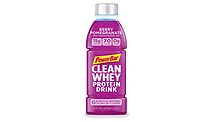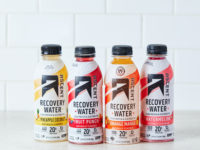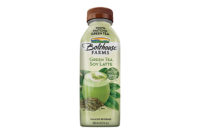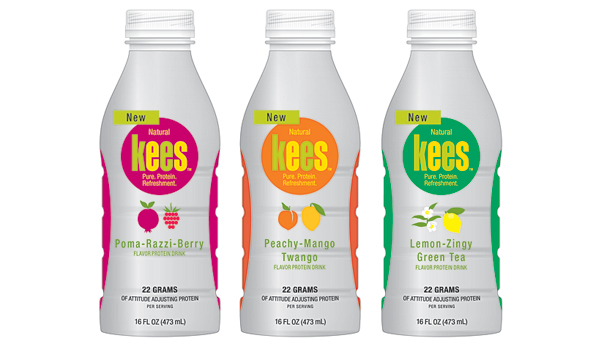Beverage sweeteners stevia and erythritol use on the rise
Masking agents overpower associated off-notes with these beverage ingredients


Blossom Water’s fruit- and flower-essence-infused waters are sweetened with a blend of blue agave nectar and erythritol. (Image courtesy of Blossom Water LLC)


In 2013, 245 new beverage products were launched that included stevia, stevia extract or erythritol in the ingredient panel, according to Mintel’s Global New Products Database. Bai5 Molokai Coconut is sweetened with organic stevia and erythritol. (Image courtesy of Bai Brands LLC)




Whether for new product launches or reformulations, natural zero-calorie sweeteners like stevia and erythritol are gaining ground in the beverage market, says Melanie Goulson, sweetness applications leader for Cargill, Minneapolis.
According to Chicago-based Mintel’s Global New Products Database, 245 new beverages were launched in 2013 that included stevia, stevia extract or erythritol in the ingredient panel compared with 87 in 2012.
Robert Brooke, chief executive officer of Stevia First, Yuba City, Calif., says that the proliferation of stevia-sweetened food and beverage products is a testament to the research and development (R&D) advances that beverage manufacturers are accomplishing.
“[W]hat it does demonstrate is the R&D groups at major bottlers and large beverage companies are actively pursuing and producing a variety of stevia products and testing them across the world in certain markets and seeing what gets traction, so there certainly has been a lot of work done there,” he says.
As these zero-calorie sweeteners gain steam, Cargill’s Goulson says one of the catalysts for these increases are health and wellness trends. “A desire to live well is driving consumers to seek a healthier lifestyle, and that includes closely examining their food and beverage choices,” she says.
David Nichols, global marketing manager for PureCircle USA, Oak Brook, Ill., notes that members of the food and beverage industries are playing an integral role in increasing the number of healthful choices for consumers.
“As the U.S. faces one of the highest obesity rates in the world, its industry players are facing significant pressures to reduce calories yet maintain great taste,” he says. “No-calorie sweeteners can help, and stevia, as an all-natural, zero-calorie sweetener, offers the industry a sweet solution that satisfies consumer demand for great taste while also naturally reducing calories to address pressures for healthier foods and beverages.”
Also giving credence to sweeteners like stevia and erythritol is the fact that they are derived from sources found in nature.
“The sweet molecules found in the stevia leaf are extracted from dried leaves with water and then the sweet components of the leaf, steviol glycosides, are purified,” Cargill’s Goulson explains. “… Erythritol is made by a fermentation process.”
Fermentation can be done to carbohydrates like glucose or dextrose, experts note.
These natural associations also appeal to consumers. “Another major trend is the desire for products that contain more ‘natural’ ingredients, which may be perceived as [healthier,]” says Adam Berzins, sweetener solutions technical service project leader with Ingredion Inc., Westchester, Ill. He adds that “natural” and calorie-reduction trends favor both stevia and erythritol usage.
Organic operations
A natural label is not the only way stevia and erythritol can appeal to health and wellness trends. Suppliers also are developing products that can meet the U.S. Department of Agriculture’s (USDA) regulations when it comes to organic certification.
Last year, Naples, Fla.-based Pyure Brands LLC launched a commercial-grade USDA certified organic and Non-GMO Project Verified erythritol.
Most recently, Sweet Green Fields, Bellingham, Wash., announced that it created a fully compliant USDA certified organic stevia product line.
Michael Quin, senior vice president of sales and marketing for Sweet Green Fields, says there is a strong interest from all segments of the beverage industry for products that are sweetened with organic stevia.
“Companies are gravitating to organic as consumer perceptions of products labeled organic are considered healthier,” he explains. “In addition, some companies have found it challenging to label products ‘natural’ when there is no [Food and Drug Administration] (FDA) definition. Organic, on the other hand, has very specific certification criteria that must be achieved to earn the USDA organic label. Sweet Green Fields took two years to develop a most rigorous organic program that includes a fully USDA-compliant proprietary organic extraction method.”
Sweet solutions
Although beverage manufacturers are developing more products to help consumers attain their healthful and natural goals, taste also is an important consideration during formulation. Many suppliers note that sweet-eners like erythritol and stevia can fulfill those criteria.
“Stevia is an attractive sweetening ingredient because the steviol glycoside extracts used in the formulation offer a sweetness intensity that is exponentially greater than sugar,” says Amy Lauer, marketing manager for North America for Tate & Lyle, Hoffman Estates, Ill. “With the rise in demand for low-sugar sweeteners, stevia has attracted attention as a natural, lower-sugar and [lower]-calorie alternative.”
Tate & Lyle sources its stevia from China where it undergoes aqueous extraction, Lauer explains. In the United States, the extract undergoes a proprietary purification process to achieve the required composition for its Tasteva product.
“Tasteva was developed through an extensive evaluation of how taste quality is affected by glycoside composition, specifically through Tate & Lyle’s extensive isolation, separation and sensory expertise,” Lauer explains.
Suppliers also are offering product-specific solutions to help manufacturers achieve their calorie-reduction goals. PureCircle’s Stevia 3.0 approach focuses on customizable formulations to identify the optimal stevia ingredient or combination, Nichols explains.
“With this approach, beverages have successfully pushed beyond the limitations of [Rebaudioside A] (Reb A), to achieve deeper calorie reductions with superior taste,” he explains.
However, when it comes to formulating with stevia, many suppliers emphasize the rule that less is more. Alex Woo, vice president of innovation and application for Sweet Green Fields, notes that beverage-makers should begin formulation at the lowest usage level possible and make adjustments from there.
“In the U.S., natural stevia extracts are typically
used in reduced-calorie and diet beverages starting at 0.005 percent,” he says. “Theoretically, at 300 times sugar potency, they can be used at up to 0.05 percent in high-sugar-equivalent diet beverages, but [manufacturers have] very seldom done so.”
Woo explains that beverage manufacturers rarely go to this level because of cost savings and taste. “If you can find a way to use less, it actually will taste better, so less is more,” he says.
Erythritol, however, is limited in its usage composition in finished beverages. “There are legal limits on the amount of erythritol [allowed] in beverages to help with some of the consumption concerns that can be associated with sugar alcohols,” Ingredion’s Berzins explains.
As a bulk sweetener, erythritol has a low caloric contribution and its sweetness is about 70 percent that of sucrose, he adds. Berzins notes that Ingredion’s Erysta crystalline erythritol is non-hygroscopic for applications where ease of flow is important, and it is heat stable up to 356 degrees Fahrenheit.
Cargill’s Goulson adds that erythritol on its own has a clean, sweet taste, but in combination, it is complementary to stevia. “In addition to added sweetness intensity, combinations of stevia and erythritol can have a positive effect on sweetness quality by contributing to quicker sweetness onset, a more rounded sweetness profile, and reduced lingering and side-tastes,” she explains.
Masked avengers
Although stevia and erythritol offer beverage-makers natural, zero-calorie options, there still are some challenges to consider when formulating with these sweeteners.
“The taste profile of stevia does not replicate that of sucrose; it exhibits a delayed onset of sweetness and, when used at high levels, can impart an off-taste of licorice or bitter with a lingering sweet [taste],” says Laura Ennis, senior innovations supervisor of beverage applications for David Michael, Philadelphia. “Stevia works best when combined with other sweeteners. Erythritol is a sugar alcohol, is considered natural, and blends very well with stevia or other sweeteners. Utilizing either of these sweeteners may require using a masking ingredient or flavor to cover the off-notes and deliver an overall better-tasting product.”
Rob Bent, food technologist for Brooklyn, N.Y.-based Virginia Dare, explains that erythritol is relatively mild and rarely contributes significant off-notes in most beverage applications; however, its limited
use rates of 3.5 percent in a beverage and associated costs should be considered when formulating. “At
3.5 percent, erythritol produces a level of sweetness equivalent to only about 2.5 percent of a sucrose solution,” he explains. “Erythritol can work well in conjunction with higher-intensity, natural sweeteners such as stevia and/or monk fruit when a zero-calorie product is desired.”
Phyllis Williams, assistant director of the flavor applications laboratory and sensory evaluation for Robertet Flavors, Piscataway, N.J., notes that erythritol has a cooling aftertaste while stevia’s profile is reminiscent of anise. Because of these aftertastes, beverage manufacturers can turn to flavorhouses to minimize these effects in the final product.
“Masking agents and taste modu-lators can decrease the perception of certain aftertaste notes such as anise-like or cooling effects,” she explains. “They can also increase the lingering of desirable sweetness characteristics.”
Utilizing a sensory panel, Robertet enacted its Essential Balance system of natural taste modulators. The panel evaluated new raw materials and their impact on sweetness perception, astringency, bitterness and sourness and then selected the most effective materials for the system, Williams says.
“Designed with natural materials, Robertet’s Essential Balance products have proven to be very effective in improving the sugar profile and mouthfeel of reduced-sugar and stevia-sweetened products,” she adds.
Virginia Dare’s Bent adds that when looking to mask undesirable tastes, it is important to consider the full scope of the finished product. “The performance of any masking ingredient is highly dependent upon the specific types of flavors and the entire ingredient matrix of the beverage being developed,” he says. “It’s important to work with the flavor system developer to tailor a masking solution for the specific beverage.”
Opportunities ahead
As stevia and erythritol sweeteners grow in popularity, suppliers are looking at more ways they can bring cost-effective solutions to beverage manufacturers.
Robert Brooke, chief executive officer of Stevia First, Yuba City, Calif., notes that the company is working to use fermentation processes to help bring costs down and offer a more reliable supply chain to support global demand. For instance, he says products like PepsiCo’s Pepsi Next brand in Australia or The Coca-Cola Co.’s Sprite brand in the United Kingdom contain steviol glycosides in their formulations, but if manufacturers wanted to enact these formulations globally, a greater stevia supply is needed.
“In order to take products like that global, you need a much more reliable and scalable supply chain for stevia, and it needs to be lower cost; you want to get the cost down,” Brooke says. “That all kind of paved the way for a new wave of growth within the stevia industry.”
Another way to help meet the growing demand is utilizing other steviol glycosides, Brooke says. Rebaudioside A (Reb A) is the form on the market used for sweetening, he says, but Stevia First is exploring fermentation and enzyme processes to convert some of the lower steviol glycosides like Rebaudioside D (Reb D) or Rebaudioside M (Reb M) into higher-value steviol glycosides.
Mel Jackson, vice president of science for Sweet Green Fields, notes that although the Bellingham-Wash.-based company is aware of the talk about other rebaudiosides, he foresees Reb A to remain at the forefront for the short term.
“We do a lot of work to understand how the industry develops, but as of yet I don’t think those are products that are anytime really going to replace what’s currently out there now,” he says. “There’s a lot of development work to be done in all of these areas.”
Looking for a reprint of this article?
From high-res PDFs to custom plaques, order your copy today!













